
The Baltimore and Ohio Railroad was the first common carrier railroad and the oldest railroad in the United States with its first section opening in 1830. Merchants from Baltimore, which had benefited to some extent from the construction of the National Road early in the century, wanted to do business with settlers crossing the Appalachian Mountains. The railroad faced competition from several existing and proposed enterprises, including the Albany-Schenectady Turnpike, built in 1797, the Erie Canal, which opened in 1825, and the Chesapeake and Ohio Canal. At first, the B&O was located entirely in the state of Maryland; its original line extending from the port of Baltimore west to Sandy Hook, Maryland, opened in 1834. There it connected with Harper's Ferry, first by boat, then by the Wager Bridge, across the Potomac River into Virginia, and also with the navigable Shenandoah River.

The Capitol Limited is a daily Amtrak train between Washington, D.C., and Chicago, running 764 miles (1,230 km) via Pittsburgh and Cleveland. Service began in 1981 and was named after the Baltimore and Ohio Railroad's Capitol Limited which ended in 1971 upon the formation of Amtrak. It carries the Amtrak train numbers 29 and 30, which were previously assigned to the discontinued National Limited.

Tower City Center is a large mixed-use facility in Downtown Cleveland, Ohio, on its Public Square. The facility is composed of a number of interconnected office buildings, including Terminal Tower, the Skylight Park mixed-use shopping center, Jack Cleveland Casino, Renaissance Cleveland Hotel, Chase Financial Plaza, and Tower City station, the main hub of Cleveland's four RTA Rapid Transit lines.

The Capitol Limited was an American passenger train run by the Baltimore and Ohio Railroad, originally between New York City and Grand Central Station in Chicago, Illinois, via Union Station, Washington, D.C., Baltimore and Pittsburgh. For almost 48 years, it was the B&O's flagship passenger train, noted for personalized service and innovation. At the time of its discontinuation on May 1, 1971, when Amtrak took over most rail passenger service in the U.S., the Capitol Limited operated between Washington and Chicago.

Martin Luther King Jr. Plaza is the main passenger rail and intercity bus station of Toledo, Ohio.

The National Limited was the premier train of the Baltimore and Ohio Railroad (B&O) on its route between Jersey City, New Jersey and St. Louis, Missouri, with major station stops in Washington, D.C., and Cincinnati, Ohio. It operated from 1925 to 1971. For much of its life it offered exclusive all-Pullman service, and it was the first long-distance train to be entirely air-conditioned. The National Limited was one of many trains discontinued when Amtrak began operations on May 1, 1971. Amtrak revived the name for another New York–St. Louis service which did not use the B&O route.
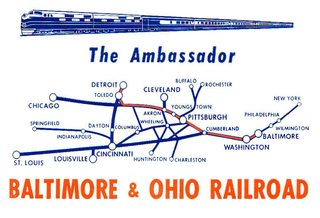
The Ambassador was a named train of the Baltimore and Ohio Railroad (B&O) on its route between Baltimore, Maryland and Detroit, Michigan with major station stops in Washington, D.C., and Pittsburgh, Pennsylvania, and Toledo, Ohio. Inaugurated in 1930, the Ambassador was discontinued in 1964.
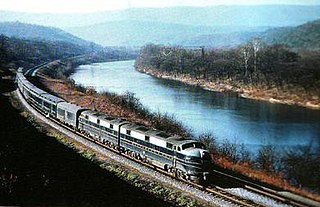
The Shenandoah was an American named passenger train of the Baltimore and Ohio Railroad (B&O), one of four daily B&O trains operating between Jersey City, New Jersey and Grand Central Station in Chicago, Illinois, via Washington, D.C. and Pittsburgh, Pennsylvania from the 1930s to the 1950s. Other B&O trains of that period on the route were the Capitol Limited, Columbian, and the Washington–Chicago Express. An alternate branch originated in Detroit and met with the Chicago part of the train at Deshler, Ohio, south of Toledo.
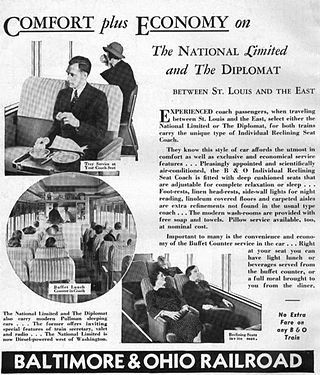
The Diplomat was a named passenger train of the Baltimore and Ohio Railroad (B&O) during the 1930s–1950s connecting New York City and St. Louis, Missouri, via Washington, D.C. Other B&O trains on the route during that period were the premier National Limited and the workhorse Metropolitan Special. The train was inaugurated in August 1930 after several changes to trains along the St. Louis Route. After World War II, the Diplomat operated as Train No. 3 westbound, and No. 4 eastbound. It was timed to provide connections to several western railroads that terminated in St. Louis, including the Frisco, the Santa Fe, Cotton Belt and Missouri Pacific, among others.

The West Virginian, train #23 and #24, was operated by the Baltimore and Ohio Railroad on a route from New York to Parkersburg, West Virginia. As with all B&O trains, the New York destination was a misnomer since trains never actually entered New York City. Instead, the B&O used the Central Railroad of New Jersey’s Jersey City Depot, which was directly across the river from New York.

The Daylight Speedliner was an American named passenger train of the Baltimore and Ohio Railroad (B&O) in the 1950s and early 1960s. Equipped with three or four streamlined, self-propelled Budd Rail Diesel Cars (RDCs) coupled together, it initially operated between Philadelphia, Pennsylvania and Pittsburgh, Pennsylvania, via Baltimore, Maryland, and Washington, D. C., as Trains #21–22.

The Washington–Chicago Express, an American named passenger train of the Baltimore and Ohio Railroad (B&O), was one of four daily B&O trains operating between Washington, D.C., and Chicago, Illinois, via Pittsburgh, Pennsylvania during the 1930s–1960s. Other B&O trains of that period on the route were the Capitol Limited, Columbian, and the Shenandoah.
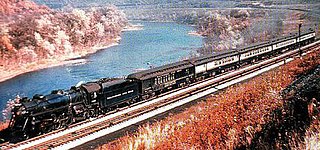
The Washingtonian was one of two daily American named passenger trains operated by the Baltimore and Ohio Railroad (B&O) during the 1940s–1950s between Baltimore, Maryland and Cleveland, Ohio, via Washington, D. C. and Pittsburgh, Pennsylvania. It was the last B&O long-haul passenger train to be powered by a steam locomotive from the venerable railroad's namesake city.

The Marylander was a Baltimore and Ohio Railroad (B&O) afternoon passenger train between New York City and Washington, D.C., operated by the B&O in partnership with the Reading Railroad and the Central Railroad of New Jersey between Jersey City, New Jersey, and Washington, D.C.. Other intermediate cities served were Philadelphia, Wilmington, Delaware, and Baltimore, Maryland. The Marylander's origin can be traced back to the late 1890s, when the B&O began its famed Royal Blue Line service between New York and Washington. Operating as #524 northbound and #525 southbound, the trains were called the New York Express and the Washington Express, respectively, in the 1910s and 1920s. The Marylander and its predecessors offered a high level of passenger amenities, such as parlor cars with private drawing rooms, full dining car service, deluxe lounge cars, and onboard radio and telephone service. The Marylander made history in 1948 when it was the first moving train to offer onboard television reception. It was one of B&O's faster trains on the route, maintaining a four-hour schedule until its discontinuation in October 1956 due to declining patronage.

The Blue Ridge Limited was one of six daily American named passenger trains operated by the Baltimore and Ohio Railroad (B&O) during the late 1930s between Washington, D. C. and Chicago, Illinois, via Pittsburgh, Pennsylvania. Inaugurated in 1934, the once high-status train was discontinued in 1949.

The Chicago Night Express was an American named train of the Baltimore and Ohio Railroad (B&O) on its route between Wheeling, West Virginia and Chicago, Illinois with major station stops in Newark, Ohio, Mansfield, Ohio and Willard, Ohio. The B&O inaugurated the Chicago Night Express in 1912. It was discontinued in 1956 due to declining passenger demand.

The West Virginia Night Express was an American named train of the Baltimore and Ohio Railroad (B&O) on its route between Chicago, Illinois and Wheeling, West Virginia, with major station stops in Willard and Newark, Ohio. The B&O inaugurated the West Virginia Night Express in 1912. It was discontinued in 1956 due to declining passenger demand.
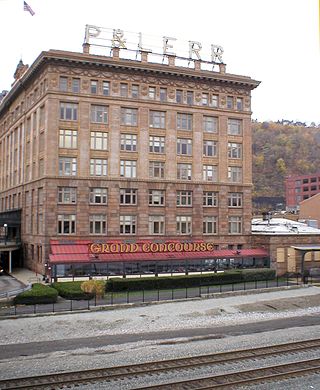
The Pittsburgh & Lake Erie Railroad Station, now Landry's Grand Concourse restaurant in Station Square Plaza in Pittsburgh, Pennsylvania, is an historic building that was erected in 1898. It was listed on the National Register of Historic Places in 1974.
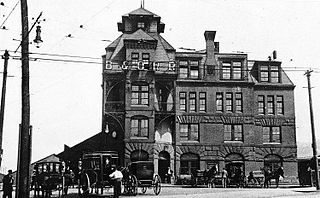
B&O Railroad Depot was one of several railroad stations in the city of Pittsburgh, Pennsylvania during the late 19th and early 20th century. The station was built in 1887, 16 years after the B&O Railroad opened its first railroad line into Pittsburgh. The station was built next to the Monongahela River. B&O railroad trains also used the Pittsburgh & Lake Erie Railroad Station for services that continued westward towards Chicago via the Pittsburgh & Lake Erie Railroad. In 1955 the station was demolished to make room for an interstate highway and remaining services were transferred to Grant Street Station. The building was designed by Frank Furness who also constructed the B&O Railroad's Philadelphia station.

Akron Union Station was a series of three union stations serving several passenger railroads in Akron, Ohio from 1852 to 1971. The station's tenants included the Baltimore & Ohio Railroad, Pennsylvania Railroad and Erie Railroad. It was a hub, serving train companies serving destinations in different directions, west, north, south and east.




















